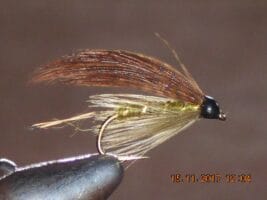Your cart is currently empty!
Red tag wet fly
Premium quality wet flies at the best discounted prices . Shipped worldwide.
Description
Red Tag Wet Fly: Classic English Pattern
The Red Tag wet fly represents a masterful approach to traditional wet fly design, combining English heritage with proven fish-catching effectiveness. This meticulously crafted pattern, originally designed by Martyn Flynn in mid-19th century England as the “Worcestershire Gem,” features carefully selected materials that create a compelling profile in the water, making it particularly effective for trout and grayling.
Design Excellence and Innovation
The pattern showcases sophisticated yet simple design elements that set it apart from standard wet flies. Its carefully engineered red tag provides perfect attraction and visibility, while the classic soft hackle creates a highly natural yet visible profile that fish readily recognize. The combination of traditional materials and precise proportions makes it particularly successful across different fishing situations.
Material Selection and Technical Construction
Every component is carefully selected for both performance and durability:
- Premium red floss tag
- High-quality soft hackle
- Strategic material placement
- Durable thread base
- Classic hook selection
- Reinforced construction techniques
Strategic Fishing Applications
This pattern excels in multiple fishing scenarios:
- Down and across presentations
- Various water types
- Multiple conditions
- Different depths
- Diverse situations Each environment allows the pattern to showcase its effectiveness.
Seasonal Effectiveness
The pattern demonstrates remarkable productivity throughout the year:
- Spring: Early season
- Summer: Evening fishing
- Fall: General searching
- Winter: Midday activity Seasonal adaptations in presentation maximize success.
Species-Specific Performance
While primarily designed for grayling, the pattern proves deadly for:
- Various trout species
- Pattern-matching fish
- Selective feeders
- Various game species
- Technical water fish
Water Presentation Characteristics
Superior presentation qualities include:
- Natural movement
- Perfect silhouette
- Realistic profile
- High visibility
- Traditional appeal
Advanced Retrieval Techniques
To maximize the pattern’s effectiveness:
- Traditional wet fly swing
- Short strips
- Various speeds
- Pattern manipulation
- Depth control
Technical Advantages
Key performance benefits include:
- Superior movement in water
- Natural presentation
- Excellent visibility
- Durable construction
- Multiple fishing applications
Line and Leader Configuration
For optimal presentation:
- Weight-forward floating lines
- Traditional wet fly setup
- 4X-5X tippet recommended
- Fluorocarbon options
- Proper turnover design
Environmental Adaptability
The pattern performs consistently across:
- Various water clarities
- Different current speeds
- Multiple water types
- Various light conditions
- Different temperature ranges
Competition and Professional Applications
The Red Tag wet fly has established itself in serious angling:
- Time-tested pattern
- Guide’s choice for searching
- Professional competition use
- Teaching pattern
- Reliable producer in challenging conditions
Size Variations and Pattern Modifications
Available in multiple configurations:
- Sizes 10-14
- Body density options
- Hackle variations
- Color modifications
- Profile adjustments
Storage and Maintenance Requirements
To maintain optimal performance:
- Store in ventilated compartments
- Protect materials
- Regular inspection
- Proper drying essential
- Hook maintenance
Advanced Rigging Techniques
Multiple rigging options enhance versatility:
- Traditional wet fly setup
- Multiple presentation methods
- Various leader designs
- Different tippet options
- Depth control methods
Historical Context and Evolution
The pattern’s development reflects:
- English fly fishing heritage
- Time-tested materials
- Refined proportions
- Proven effectiveness
- Continuous relevance
Quality Control Standards
Each fly maintains strict requirements:
- Precise material placement
- Proper proportioning
- Construction integrity
- Material selection
- Pattern uniformity
Fishing Location Selection
Optimal fishing locations include:
- Various streams
- Different currents
- Feeding lanes
- Structure edges
- Transition zones
Weather and Condition Considerations
Pattern effectiveness varies with:
- Light conditions
- Water clarity
- Cloud cover
- Temperature
- Barometric pressure
Presentation Techniques
Achieving proper presentation through:
- Accurate casting
- Proper mending
- Drift control
- Distance management
- Line control
Color and Profile Characteristics
The pattern’s coloration provides:
- Perfect attraction
- Realistic appearance
- Low-light effectiveness
- Natural match
- Effective contrast
Movement Characteristics
Natural movement achieved through:
- Hackle action
- Current interaction
- Body design
- Material flexibility
- Presentation technique
Durability Features
Construction elements ensuring longevity:
- Reinforced materials
- Quality material selection
- Proper proportioning
- Strategic construction
- Hook point protection
Target Species Behavior
Understanding fish response to:
- Natural profile
- Pattern visibility
- Movement triggers
- Feeding patterns
- Strike triggers
Water Type Adaptations
Effective across various waters:
- Various streams
- Different currents
- Multiple depths
- Different conditions
- Various structures
Casting Techniques
Specialized casting methods:
- Traditional wet fly cast
- Roll casting
- Line speed control
- Loop formation
- Wind adaptation
Strike Detection
Recognizing takes through:
- Line hesitation
- Leader movement
- Direct observation
- Visual cues
- Tactile detection
Hook Setting Techniques
Proper hook setting through:
- Timing considerations
- Pressure control
- Direction management
- Follow-through
- Fish behavior reading
Fighting Techniques
Landing fish effectively:
- Pressure application
- Direction control
- Line management
- Fish behavior adaptation
- Landing strategy
Additional information
| Hook type | Barbed Hooks, Barbless Hooks |
|---|---|
| Hook size | 10, 12, 14, 16, 18, 20 |
Related products
-
Western coachman wet fly
$ 4.00 -
Leisenring Black Gnat wet fly
$ 4.00 -
Teal and red wet fly
$ 4.00 -
scooty scooty wet fly
$ 4.00 -
Greenwells Glory Wet fly
$ 4.00







